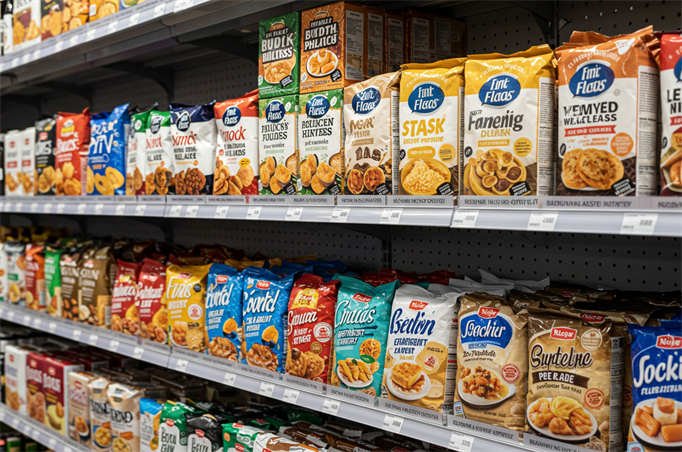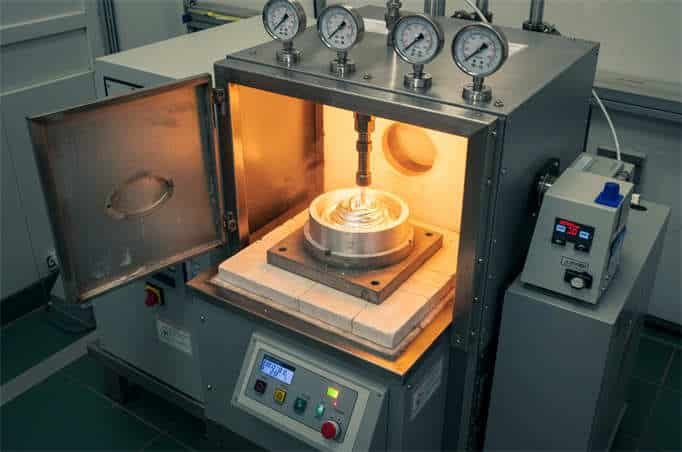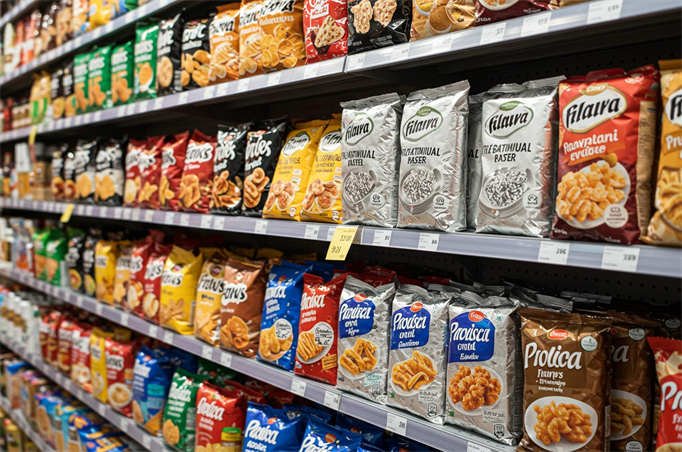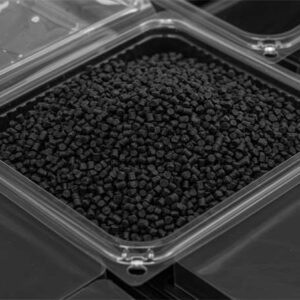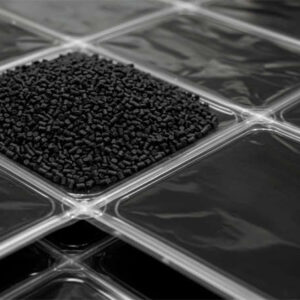الدور البارز لعجينة الألمنيوم في تغليف الأغذية الحديثة
في عالم تغليف المواد الغذائية الديناميكي، تلعب المواد المستخدمة دورًا محوريًا في ضمان جاذبية المنتج وسلامته. معجون الألومنيوموهو مكوّن رئيسي في أحبار تغليف المواد الغذائية، وقد اكتسب شهرة واسعة لخصائصه الاستثنائية. في شركة فايفر ستار نيو ماتيريالز، ننتج معجون الألومنيوم عالي الجودة لتغليف المواد الغذائية. يتعمق هذا المنشور في المدونة في الميزات وأشكال التطبيق والمزايا والتأثير على العمر الافتراضي للأغذية والمعايير البيئية ذات الصلة بمعجون الألومنيوم في تغليف المواد الغذائية وكيفية ضمان عدم وجود بقايا مذيبات بعد الطباعة. نهدف إلى تقديم رؤى شاملة حول دور وأهمية عجينة الألومنيوم في صناعة تغليف المواد الغذائية. سواءً كنت محترفاً في مجال تغليف المواد الغذائية أو مستهلكاً مهتماً بسلامة الأغذية وجودة التغليف، ستكون هذه المعلومات ذات قيمة كبيرة بالنسبة لك. انضم إلينا بينما نستكشف العالم الرائع لعجينة الألمنيوم في تغليف المواد الغذائية.
في فيفر ستار مواد جديدة، فإننا ندرك الأهمية الحاسمة لكل مكون في إنشاء عناصر آمنة وفعالة وجذابة تغليف المواد الغذائية. يعمل معجون الألومنيوم، وهو مكون رئيسي في أحبار الطباعة، على تعزيز حلول التغليف بشكل كبير. نحن نفخر بمنتجي المواد الخام المبتكرة مثل Fiver Star New Materials، الذين يصنعون معجون الألومنيوم عالي الجودة الذي يتيح هذه التطورات.
إليك كيفية رفع معجون الألومنيوم تغليف المواد الغذائية:
الخصائص الرئيسية لصق الألومنيوم في أحبار تغليف المواد الغذائية
صديقة للبيئة وغير سامة
تستخدم معاجين الألومنيوم المتقدمة عمليات طلاء خاصة باستخدام مذيبات تعتمد على الدهون أو الإستر. هذا يضمن خلوها من البنزين والكيتون، مع الحد الأدنى من بقايا المذيبات وانخفاض الرائحة. تفي هذه الخصائص بالخصائص البيئية الصارمة و تغليف المواد الغذائية معايير الاختبار، مما يقلل بشكل كبير من انبعاثات المواد الضارة ويضمن سلامة الأغذية.
مقاومة فائقة لدرجات الحرارة العالية
تُظهر عجينة الألمنيوم مقاومة ممتازة لدرجات حرارة الطهي. هذا يجعلها مناسبة للمتطلبات الصعبة تغليف المواد الغذائية التطبيقات التي تخضع للمعالجة في درجات حرارة عالية، مثل العبوات المعوجة للوجبات الجاهزة للأكل، وتغليف الأغذية المجمدة، والتغليف المحكم الغلق بالتفريغ من الهواء، وتطبيقات الختم الحراري. تظل سلامة العبوة وجودة الطباعة مستقرة حتى أثناء الطهي في درجات الحرارة العالية.
أداء الطباعة المحسّن
يوفر هذا المعجون تغطية قوية ولمسة نهائية معدنية ملفتة للنظر، مما يحسن بشكل كبير من المظهر البصري تغليف المواد الغذائية. كما أن قابليته الممتازة للتشتت تجعل المنتجات تبرز على الأرفف وتجذب انتباه المستهلكين. علاوة على ذلك، تضمن خصائصه الجيدة في النقل التوحيد والجودة في عملية الطباعة، مما يدعم خطوط الإنتاج عالية السرعة.
مقاومة ممتازة للماء والمواد الكيميائية
مقاومة المياه والمواد الكيميائية ميزة حاسمة في تغليف المواد الغذائية. على سبيل المثال، تجد شركات الألبان التي تستخدم معاجين ألومنيوم محددة (مثل ZS-710 المذكورة في تقارير الصناعة) أن أغلفة التغليف الخاصة بها تحتفظ بما يصل إلى 95% من لمعانها الأولي حتى في ظروف التبريد، كما أن طبقة الحبر تتحمل اختبارات الغمر بالماء لمدة 72 ساعة دون أن تنفصل.
التطبيقات النموذجية في تغليف المواد الغذائية
عبوات التغليف البلاستيكية
تستخدم الصناعات على نطاق واسع معجون الألومنيوم للطباعة على مختلف الأغشية البلاستيكية، مثل البوليستر والبولي بروبيلين. هذا يوفر حماية فائقة وتأثيرات بصرية للأطعمة مثل الوجبات الخفيفة والمجمدة والوجبات الجاهزة، مما يعزز من تغليف المواد الغذائية.
التعبئة والتغليف الورقي
معجون الألومنيوم يعزز معجون الألومنيوم الورقي تغليف المواد الغذائيةمثل الصناديق والأكياس. يعمل على تحسين كل من الخصائص الجمالية والخصائص الوقائية للتغليف الورقي. وغالبًا ما يستخدم في علب الهدايا الغذائية الراقية وتغليف المشروبات لإبراز جودة المنتج.
مزايا استخدام عجينة الألومنيوم لتغليف المواد الغذائية
رفع جاذبية التعبئة والتغليف
التأثير المعدني المكثف وقوة التغطية القوية لعجينة الألومنيوم تجعل تغليف المواد الغذائية أكثر جاذبية بصرياً. هذاوهذا بدوره يزيد من القيمة المتصورة للمنتج وقدرته التنافسية في السوق، مما يشجع العملاء على الشراء.
ضمان سلامة الأغذية
ألومنيوم عالي الجودة غير سام وعديم الرائحة وصديق للبيئة يمنع المواد الضارة من تلويث الطعام. هذا يحافظ على صحة المستهلك ويتماشى مع المعايير الصارمة اليوم تغليف المواد الغذائية متطلبات السلامة.
تحسين أداء التغليف والتعبئة والتغليف
تضمن لك مزايا مثل مقاومة الحرارة والماء والمذيبات ما يلي تغليف المواد الغذائية يحافظ على سلامته عبر مختلف سيناريوهات التخزين والنقل والاستخدام، مما يساعد على إطالة العمر الافتراضي للمنتجات الغذائية.
تأثير طباعة معجون الألومنيوم على العمر الافتراضي للأغذية
تؤثر طباعة عجينة الألومنيوم على مدة صلاحية الطعام، على الرغم من أنها ليست العامل الوحيد المحدد.
المساهمات الإيجابية في العمر الافتراضي:
- خصائص الحاجز المعزز: تشكل عجينة الألومنيوم، المكونة بشكل أساسي من مسحوق الألومنيوم والمذيبات، حاجزًا فعالاً على تغليف المواد الغذائية after printing. This layer protects food from external factors like oxygen, water, and light, slowing oxidation, mould growth, and spoilage. For instance, prepared food packaging printed with aluminium paste can effectively inhibit microbial growth and extend shelf life.
- High-Temperature Performance: Its heat resistance means that during high-temperature sterilisation of تغليف المواد الغذائية, the paste does not degrade the packaging’s protective properties or release harmful substances. هذا ensures continuous protection and helps maintain food quality. هذا is common in canned and retort pouch foods.
- Antimicrobial Properties: The smooth surface of aluminium paste printing can reduce microbial adhesion. Aluminium also possesses some inherent antimicrobial properties, which can inhibit the growth of bacteria and mould, thereby contributing to a longer shelf life.
Limitations Regarding Shelf-Life Impact:
- Not the Primary Factor: Food’s shelf life primarily depends on its intrinsic characteristics, processing methods, and storage conditions. Aluminium paste printing is just one aspect of تغليف المواد الغذائية. While it contributes positively, it cannot alter the food’s inherent perishability or fundamentally determine its shelf life.
- Importance of Printing Quality: Poor aluminium paste printing, such as uneven ink layers or weak adhesion, can compromise the packaging’s protective performance. هذا would not effectively extend shelf life and might lead to premature spoilage.
Environmental Standards for Aluminium Paste in Food Packaging Inks
Several environmental standards govern the use of aluminium paste in inks for تغليف المواد الغذائية:
European Union (EU) Standards
- RoHS Directive: This directive restricts the use of certain hazardous substances (lead, mercury, cadmium, hexavalent chromium, PBBs, PBDEs) in electrical and electronic equipment, and its principles often extend to packaging materials.
- PAHs Directive: This strictly controls polycyclic aromatic hydrocarbons (PAHs) in تغليف المواد الغذائية materials. Raw materials and solvents used in aluminium paste production must comply with the requirements to ensure PAH migration does not exceed limits.
- EFSA Regulations: The European Food Safety Authority (EFSA) provides safety assessments and requirements for metallic pigments in food contact materials. Aluminium paste must comply with these regulations to ensure it does not contaminate food under normal usage conditions.
China’s National Standards
- GB 9685-2016: This standard specifies the usage guidelines for additives in food contact materials and products. Additives in aluminium paste must meet requirements regarding type, application scope, and maximum levels.
- GB 4806.10-2016: This standard details limits for hazardous substances in food contact coatings. As part of a coating, aluminium paste must meet limits for heavy metals, solvent residues, etc.
Other Key Environmental Requirements
- Benzene-Free and Ketone-Free: High-quality aluminium pastes avoid harmful solvents like benzene, toluene, xylene, and ketones to minimise environmental and health impacts. Pastes used in retort inks often use ester-based solvents to achieve this.
- Low Odour: After printing and curing, aluminium paste should have minimal odour to prevent tainting the food product and ensure worker safety.
- No Solvent Residue: Advanced production and coating technologies ensure no solvent residue remains after printing, meeting food quality standards. Water-based aluminium pastes inherently address this issue.
- Resistance to High-Temperature Cooking: For تغليف المواد الغذائية requiring high-temperature sterilisation (e.g., >120°C), the aluminium paste must withstand these conditions without releasing harmful substances or compromising package integrity.
- FDA Compliance: While a US regulation, many global تغليف المواد الغذائية companies adhere to FDA requirements. The FDA strictly regulates food contact material safety, and aluminium paste components and performance must meet relevant FDA clauses for products intended for export or high-safety applications.
Ensuring No Solvent Residue After Printing with Aluminium Paste
To ensure no solvent residue from aluminium paste remains after printing on تغليف المواد الغذائية, we recommend a multi-faceted approach:
Quality Control of Raw Materials
- Select High-Quality, Eco-Friendly Materials: Opt for aluminium pastes, like those from reputable suppliers, that use special coating processes and safer solvents (e.g., ester-based or water-based) to be inherently benzene-free and ketone-free. هذا minimises the introduction of harmful solvents from the start.
- Conduct Rigorous Testing: Implement comprehensive testing for aluminium paste, covering physical properties (particle size, aluminium content, solvent type/composition) and safety indicators (heavy metals, VOCs, RoHS, REACH compliance) to ensure products meet environmental standards.
Enhancing Printing Processes
- Upgrade Equipment: Utilise high-precision drying systems, such as those with segmented ventilation. For large-area graphics, add extra ovens to boost overall drying efficiency. Implement online gas chromatography to monitor solvent residues in real-time, allowing for oven temperature and line speed adjustments to prevent “false drying.”
- Manage Processes Carefully: Optimise pre-press design to reduce colour mixing, overprinting, and deep engravings; choose spot colours where possible. Limit metallic/pearlescent inks to non-heat-seal areas to avoid excessively thick ink layers that hinder drying—separate printing and lamination processes to prevent cross-contamination of environmental solvents. After printing, allow film rolls to ventilate for 24-48 hours before lamination.
Perfecting Post-Treatment and Curing
- Implement Low-Temperature, Long-Duration Curing: To promote solvent evaporation, cure printed aluminium paste at lower temperatures (e.g., 40-50°C) for an extended period (48-72 hours).
- Address Difficult Substrates: Unroll the film for secondary low-temperature drying before lamination for substrates that don’t easily release solvents. If necessary, use absorption-condensation methods to treat exhaust gases.
Standardised Testing and Feedback
- Standardise Testing Procedures: Use methods like DMF (dimethylformamide) dilution for sample preparation and create dynamic standard curves to check residues on printed films. For final checks on composite bags, cut samples (e.g., 0.2m²) and use headspace extraction (e.g., at 80°C) combined with GC-FID (Gas Chromatography with Flame Ionisation Detector) to test for residues like benzene, aiming for detection limits ≤ 0.01mg/m².
- Implement a Data Traceability System: Establish a solvent residue database correlating with speed, temperature, humidity, and formulation data. Use this to optimise process models and continuously improve production.
Storage and Handling Guidelines for Aluminium Paste
- Storage Requirements: Store aluminium paste in sealed containers indoors, between 15-40°C. Please protect it from direct sunlight, rain, or excessively high temperatures. Avoid excessive shaking and vibration during transport. If stored for extended periods, check for any separation of aluminium and solvent components before use.
- Operating Procedures: Use the paste immediately after opening the container. Securely seal any remaining portion to prevent solvent evaporation. Avoid high-speed stirring, which can damage the surface coating of the aluminium flakes and their integrity, affecting performance and drying.
This detailed introduction to aluminium paste in food packaging has given you a clearer understanding of its multifaceted role. As a leading aluminium paste aluminiumurer for food packaging, Fiver Star New Materials is committed to providing high-performance, environmentally friendly, safe aluminium products. We constantly strive to innovate and optimise our production processes to meet the stringent requirements of the food packaging industry. If you are looking for reliable and excellent aluminium paste for food packaging, look no further than Fiver Star New Materials. We are confident that our products will enhance the quality and safety of your food packaging. Feel free to contact us for more information or to place an order. Let us work together to create a brighter future for food packaging!




